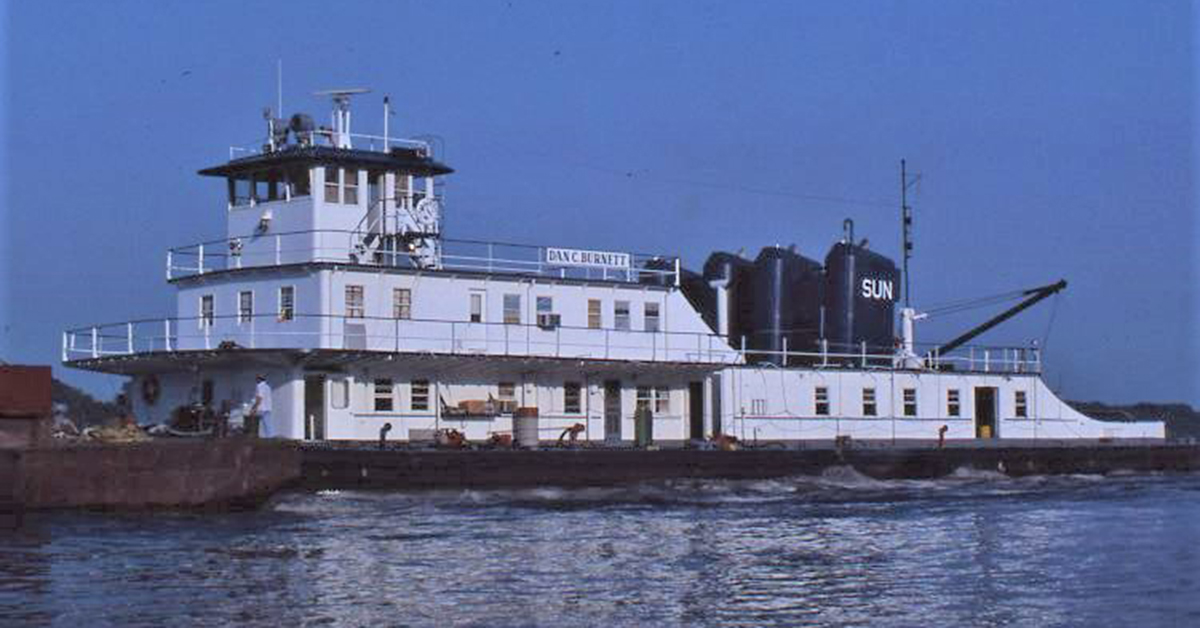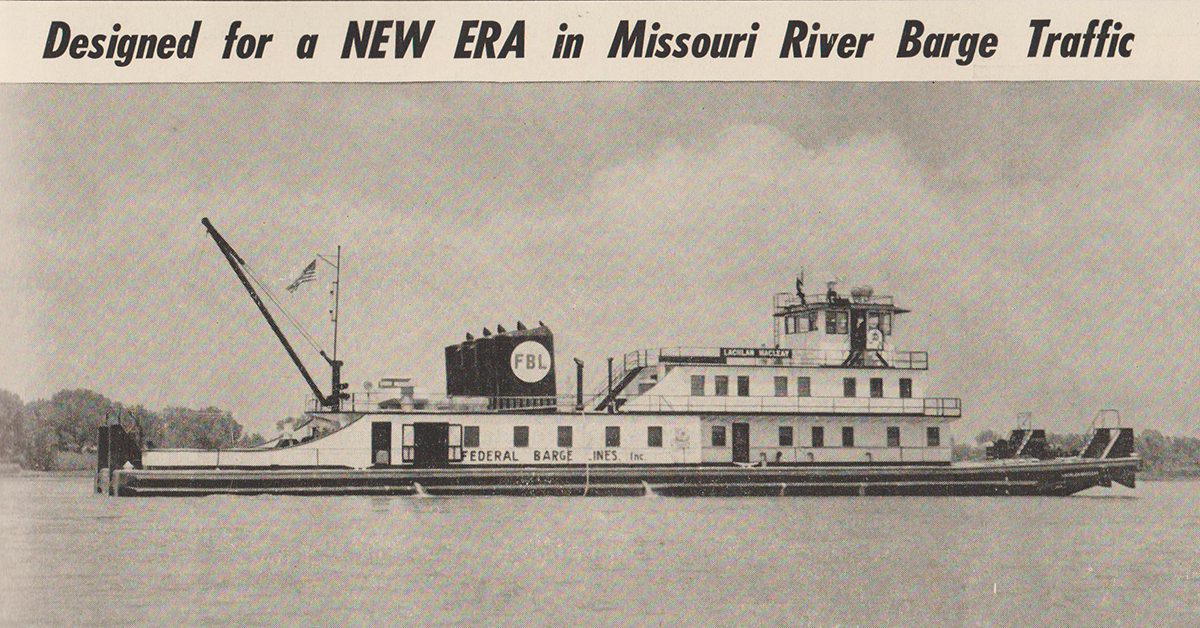The sad news was dispensed through social media recently that one of the most iconic towing vessels built for the inland rivers in the middle of the 20th century was destroyed by fire in South America, where it had been operating for the past 30 years.
Much has been written in this column about the formation of a government-owned barge line in response to a lack of viable river transportation during World War I. This began in the closing months of the war with the establishment of the Inland & Coastwise Waterways Service within the War Department. In 1924, Congress set up the Inland Waterways Corporation (IWC) to operate the entity in a more businesslike manner. Known informally as the Federal Barge Line, this concept worked and expanded reliable river barge service throughout the inland waterways. The towboats built were at first steam and then innovative diesel vessels.
From the start, the intent was for this barge line to eventually be turned over to private ownership, but the advent of World War II interfered. Following that war, there were increasing calls—especially from the railroads, who despised the concept—for the government to sell the barge line. By the late 1940s, with the IWC towboat fleet aging and in need of modernization, serious looks at privatization began. In December 1953, the Inland Waterways Service was sold to St. Louis Ship and owner Herman Pott, who placed it under a new entity formally called Federal Barge Lines.
Pott immediately began modernizing the Federal fleet, retiring steam vessels and replacing them with modern diesel towboats. Federal Barge Line for years had been promoting the use of the Missouri River. Traffic on the Missouri steadily increased following improvements by the U.S. Engineer Department/Corps of Engineers. By 1954, small stories began appearing in The Waterways Journal about an entirely new type of towboat that St. Louis Ship and Federal Barge Lines were designing for the Missouri.
The announcement was made that the new towboat would be named in honor of the late Lachlan Macleay, president of the Mississippi Valley Association from 1938 until shortly before his death in 1952. The St. Louis News Items column in the May 7, 1955, issue of The Waterways Journal reported that the new boat was launched on April 29 and, at 650 tons, was “the heaviest towboat ever launched at the St. Louis Shipbuilding and Steel Company.” A subsequent story on page five of the May 14 issue said the Macleay was christened at St. Louis on May 10.
Mrs. Donald Macleay, daughter-in-law of the namesake, formally christened the mv. Lachlan Macleay. The May 21, 1955, issue of The Waterways Journal carried a detailed description of the new boat. The most notable feature of the vessel was the fact that it was a quadruple-screw boat powered by four GM 12-567 engines, each rated 900 hp. at 750 rpm. The main engines turned 78-inch, four-blade props through gears of 3:1 reduction. The boat was open wheel with four steering rudders of the patented St. Louis Ship contraguide design. There were also six flanking rudders.
The 162- by 45-foot hull had a long forward line deck at the bow followed by a deckhouse that was wider at the engine room than the quarters area forward, creating a striking appearance. The upper cabin stretched about half the length of the main cabin, and four tall stacks were located over the engine room. The large, squarish pilothouse was above this and was on a slightly elevated riser. In this same issue of the magazine, James V. Swift described the inaugural trip of the Macleay up the Missouri as consisting of 11 loaded barges and stretching over a thousand feet, including the towboat. Federal Barge Lines veteran Capt. Leonard Thompson was master in charge of the Macleay as it “walked up the shifting channel at a steady pace averaging some four miles an hour,” Swift wrote. Receptions for the new vessel were held at Kansas City, Mo., and Omaha, Neb.
In the July 30, 1955, issue of The Waterways Journal, Capt. Thomas P. Craig, who had made the first official Federal trip up the Missouri on the mv. Franklin D. Roosevelt in 1935 (See WJ, March 20, 2023), wrote a lengthy letter extolling the virtues of the Lachlan Macleay as he traveled on it from Kansas City to St. Louis. Craig also highly praised the work of the Corps of Engineers to improve the navigation channel of the Missouri River.

In March 1963, the Lachlan Macleay was transferred to Pott Industries subsidiary Gulf-Canal Lines of Houston. In 1971, it was transferred to another subsidiary, United Barge Company of Minneapolis, and renamed Lady Slipper the following year. In December 1975, it was sold to Sun Transportation Company of Boonville, Mo., and renamed Dan C. Burnett. Capt. Dan Burnett, himself a veteran Federal Barge Lines and Missouri River pilot and captain, was the head of Sun Transportation.
Many that worked on and around this boat during this ownership recall what a good towboat it was and how well it did on the Missouri. These included Bill Burnett, the son of Capt. Dan C. Burnett, and Capt. Dave Dewey. Dewey has mentioned how well the boat handled even without outboard flanking rudders, which were removed due to the boat negotiating the close confines of the Missouri channels. Dewey also commented on the excellent pilot’s perspective gained from gazing across the tow from behind the long bow of the boat.
The mv. Dan C. Burnett was last listed in the 1995 “50th Anniversary” issue of the Inland River Record and appeared in the Off The Record section the next year. The 1996 edition of IRR noted that the boat had been sold to RTZ Mining Company of Brazil in December 1994, taken to South America and renamed Julie. A recent social media post shared by Bill Burnett contained a video and a news story about the Julie being “consumed by a fire of large proportions in the waters of the Paraguay River, in the area of the Remanso Bridge” on May 10 of this year. The story said that the incident was still being investigated, but the fire had apparently started in the engine room.
Featured image caption: The mv. Lachlan Macleay in a St. Louis Ship ad from June 18, 1955, issue of The Waterways Journal. (From the author’s collection)



